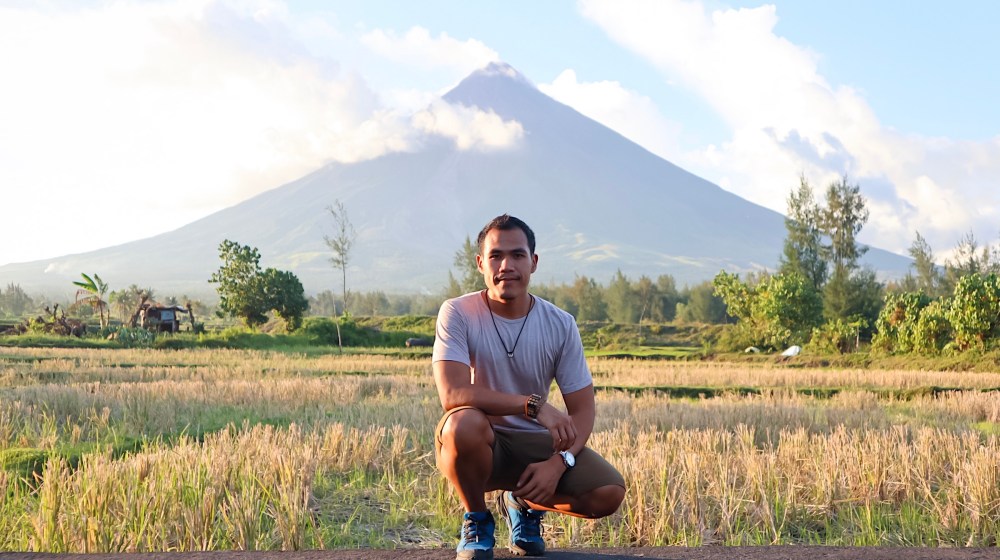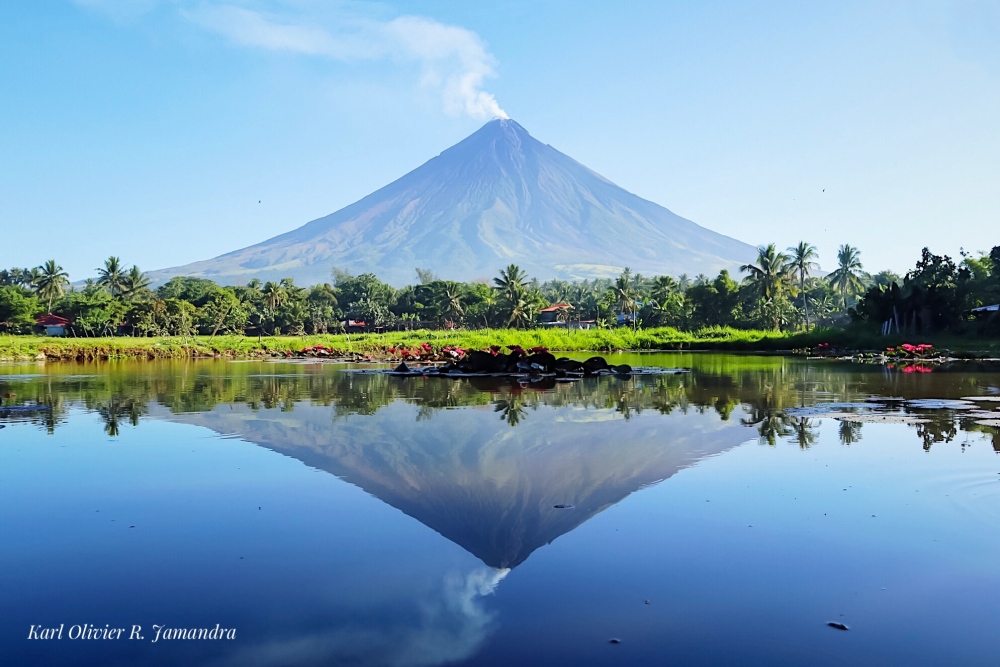
It’s been months since I’ve been chosen as one of the ten finalists of Wranger Philippine’s #TrueWanderer but I’m still very thankful for the honor and the opportunity that came with it. As a way of giving back, I want to share my experience and itinerary for the travel that I did for the contest. Traveling solo, I went to explore the province of Albay, home to the most renowned volcano in the whole Philippines: Mt. Mayon.
ALBAY

One of the six provinces of the Bicol region, Albay is located in the southern tip of Luzon island, just above the province of Sorsogon. Even though it is almost always synonymous to Mt. Mayon, Albay offers other natural wonders and idyllic places that you can go to and visit. Their food, known for its spiciness, is to yearn for when traveling here. Don’t forget to try pinangat, bicol express and huge scoops of spicy ice cream when you’re here! Moreover, some of the oldest churches built in the country can also be found in this province. It is said that the first mass in the whole Luzon was celebrated here in a small chapel, which would then become the mother of all churches of the entire island region.
Now, let me share with you what activities you can do and places you can explore for two days in the land of Mt. Mayon.
PLACES TO EXPLORE
Mt. Mayon
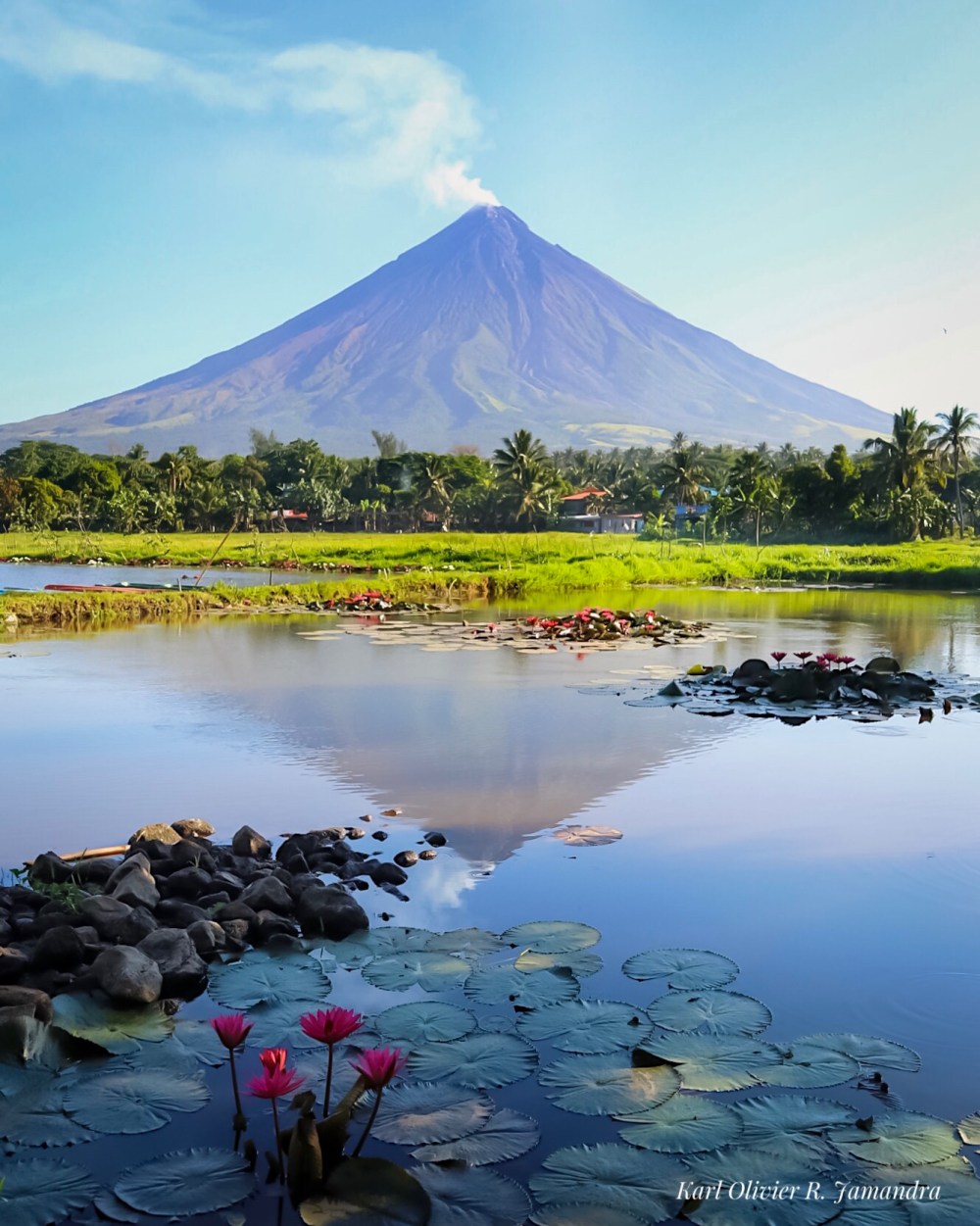
The Perfect Cone. A UNESCO World Heritage Site. A Beautiful disaster.
Mayon Volcano has these names and descriptions – a testament as to how important it is. Whatever you may call it, there’s no denying that Mayon is one of the country’s most attractive travel destinations. It is that volcano that has ingrained and continuously ingraining in its people a unique culture by affecting their way of life surrounding it.
Geographically shared by the two cities and six municipalities of Albay, Mayon is the iconic symbol of the said province, and truthfully, the whole Bicol Region as well. Although posing distress every now and then as it is the most active volcano in the Philippines, Mayon has paved the way to inspire and encourage tourists, foreigners and locals alike, to visit Albay. This boom in tourism in spite of the undeniable danger that it brings makes Mayon a paradox. How can something that gives people harm also give them life?
All these things make up the beauty and wonder that is Mayon. I have always been fascinated by this volcano ever since I have read about it when I was a child. I have long aimed to capture it within the frames of my camera. I’ve been to Albay twice before but have failed to take a decent picture of it. For my Wrangler Philippines’s #TrueWanderer travel adventure, I made this my number one goal: to capture Mayon’s beauty in full, that is, without obstruction. And thank God, I did it!
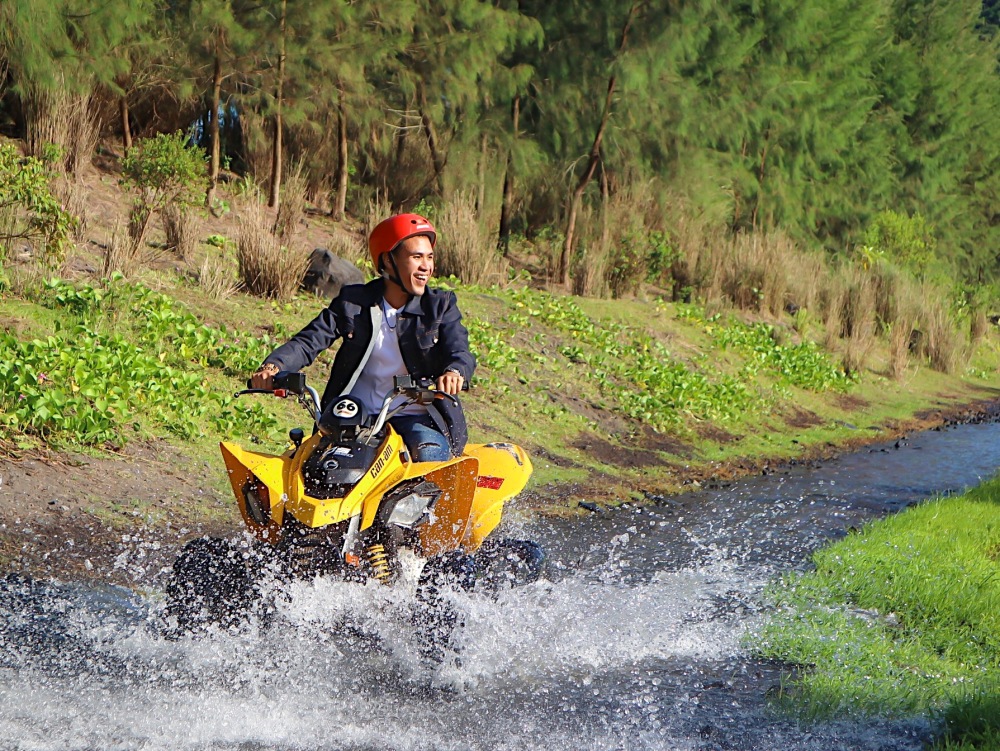
One of the best things to do while around the area of Mt. Mayon: riding the ATV!
I welcomed my #TrueWanderer travel adventure by riding the ATV towards the base of Mt. Mayon! It’s not my first time to ride the ATV, but I have always wanted to ride it on a trail towards the beautiful, feared yet revered volcano of Bicolandia. The thought of being able to do it right before the event made my heart skip a bit. And guess what, while doing this adventurous activity, I seemed like in euphoria! Haha. I guess what you truly feel really does show in the outside. Just look at my picture here!
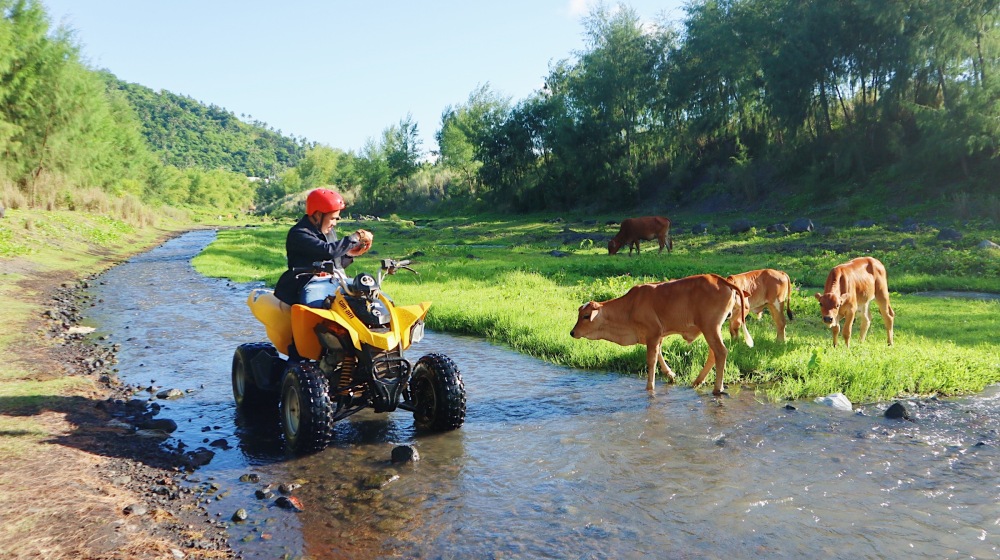
Driving the ATV was easy but driving it along bumpy roads and shallow yet stony river is quite challenging. If you’re not careful, you might even flip or fall! I could say that my ATV adventure was tiring, yet it was a fulfilling one.
SUMLANG LAKE

One of the best places to go to if you want to see Mt. Mayon in all its majestic splendor is none other than Sumlang Lake in the municipality of Camalig. The word sumlang is said to derive from the Bicolano word islang, which means bamboo shoots. Islang is common in the area where the lake is located, and this is a reason why people also harvest it for food.

Activities that can be done here include raft boating, kayaking and fishing. There are stores around the area, so if you want to eat here, you can.
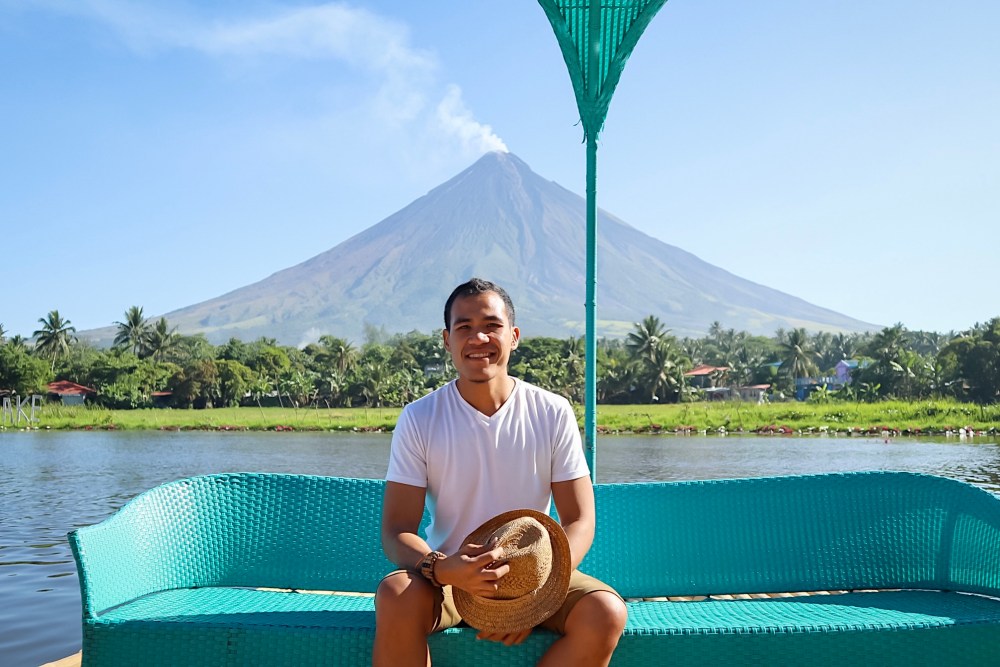
CAGSAWA RUINS
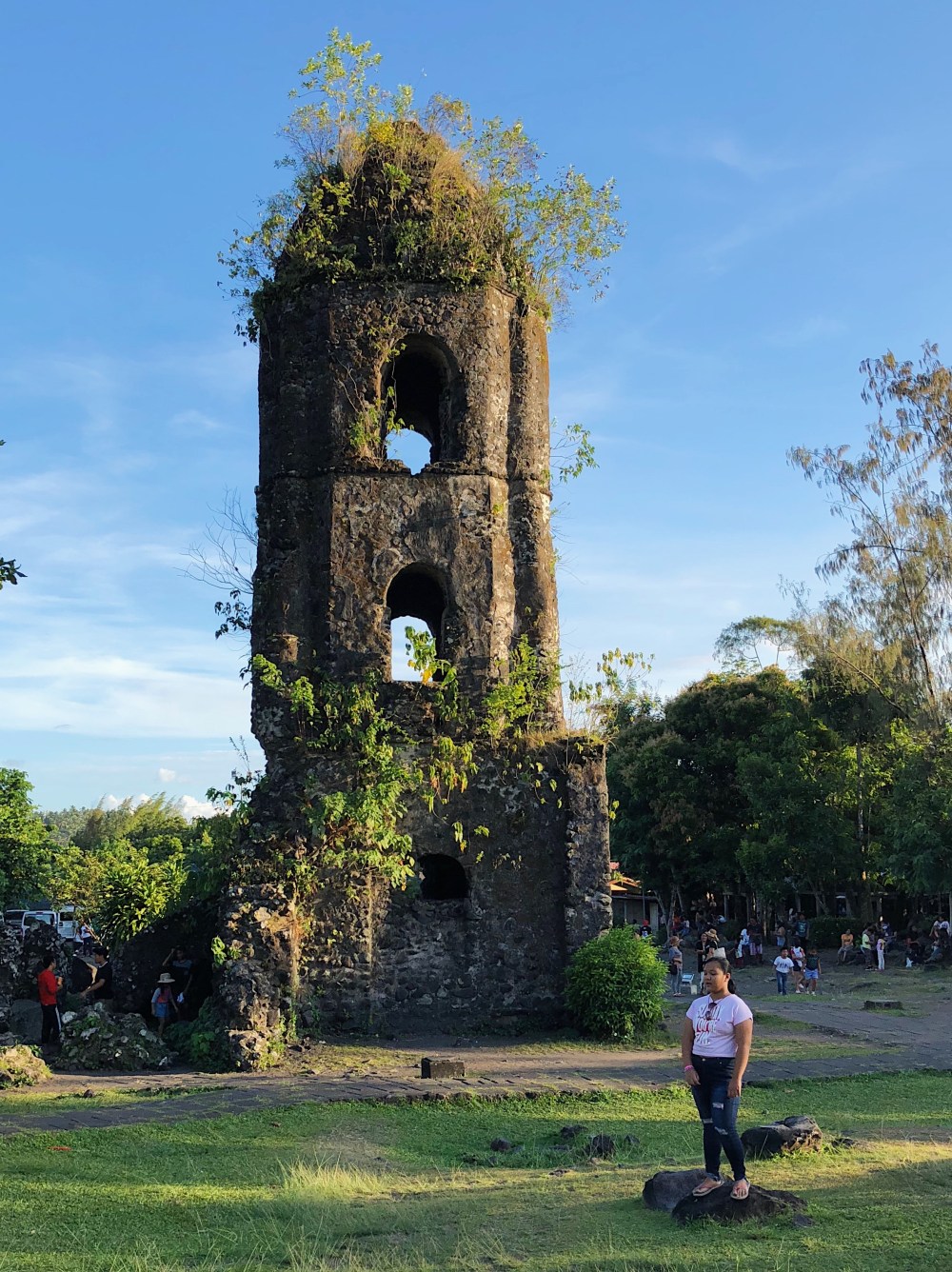
Probably the most visited area in Albay, Cagsawa Ruins is a great place to go to if you’re looking for a good view of Mt. Mayon. Once the sight of the colonial settlement of Cagsawa, it is now declared a National Cultural Treasure by the National Museum of the Philippines and a Cultural Heritage Site by the National Historical Institute. This just goes to show how important this place is.
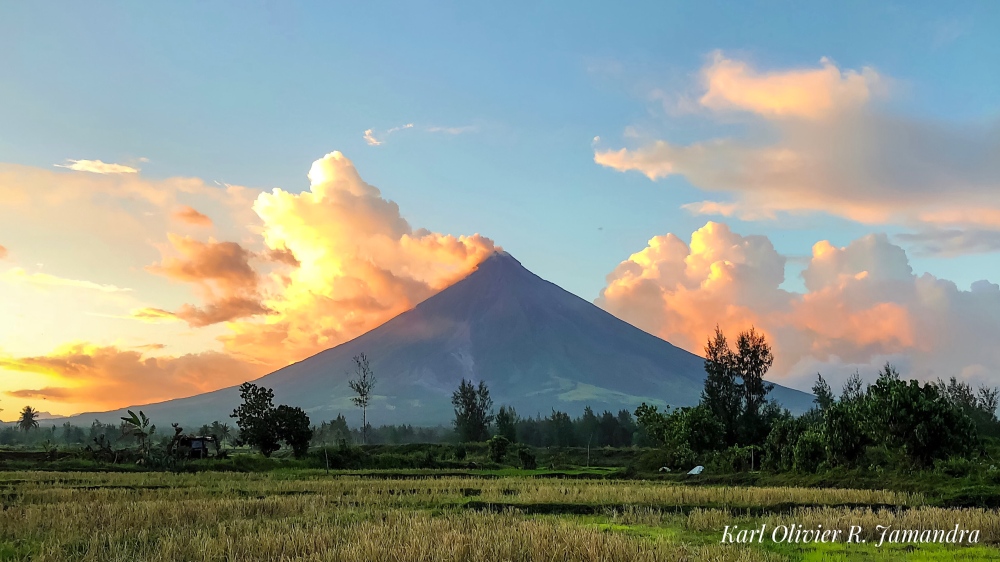
A little background: It was on Feb. 1, 1814 when Mayon Volcano erupted and destroyed the community, and what remains here include the ruins of the church, the convent and the bell tower. The bell tower, with Mt. Mayon in the background, is one of the most photographed structures in the Philippines.
Up for another story in Cagsawa?
While waiting for the sunset in the ruins, I noticed a 12-year-old child asking tourists if they wanted their pictures taken. When they said no, he went and talked to me. He wasn’t really convincing me to take pictures just like what he was doing with the others. He was just there telling me his story, such as anecdotes about him being a “tour guide.” His name was Steven.
He said he started going to the ruins at the tender age of 6. It seemed like he already knew the value of money even back then. He said that whatever he earned for “guiding,” he would give it to his parents to help. He said he’d be happy the day after because his parents would give him more baon for school. He also said he’s able to buy a bike for himself! Unfortunately, his bike is currently damaged so he want back to walking going to and from school.
After a while, his two other friends joined us. They also told me their stories, albeit briefly. Julius was carrying with him a handsome bike. He proudly told me he really saved up for it, and he’s really happy about using it now. Roger, their other friend, said he’s already in high school and that he’d go to the ruins because it’s summer break.
When Steven told me he wanted to take pictures of me because it was already getting dark, I let him even just for a few shots. I asked if I could take pictures of them afterwards, they agreed. And after telling them to keep going to school and study hard, I gave them a few bills just for a little help. They gladly said they will.
Still young and innocent yet already this hardworking, these kids reflect what other kids in our country experience in their daily lives. If you think your life is hard, think about them. They’re still kids yet they’re already working instead of just studying and playing around!
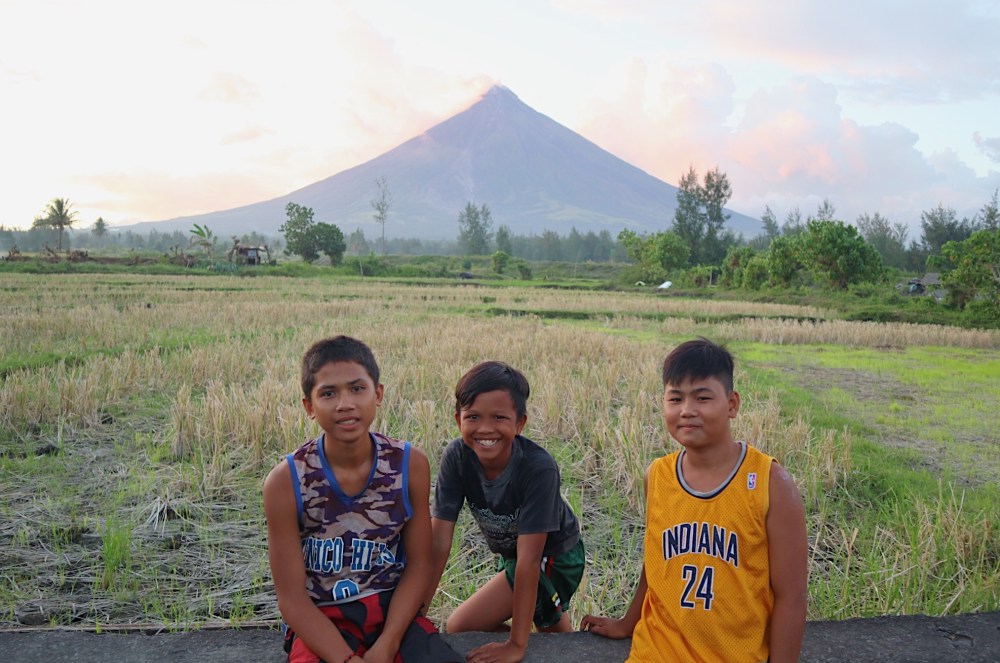
DARAGA CHURCH

I made a short visit to Nuestra Senora de la Porteria Parish Church, more popularly known as Daraga Church, after visiting the Cagsawa Ruins. It was already night, but it didn’t mask the beauty of the church, which was built in 1772 by the Franciscan order. I have visited the church before during the afternoon, and it also has a good view of Mayon.
QUITINDAY HILLS
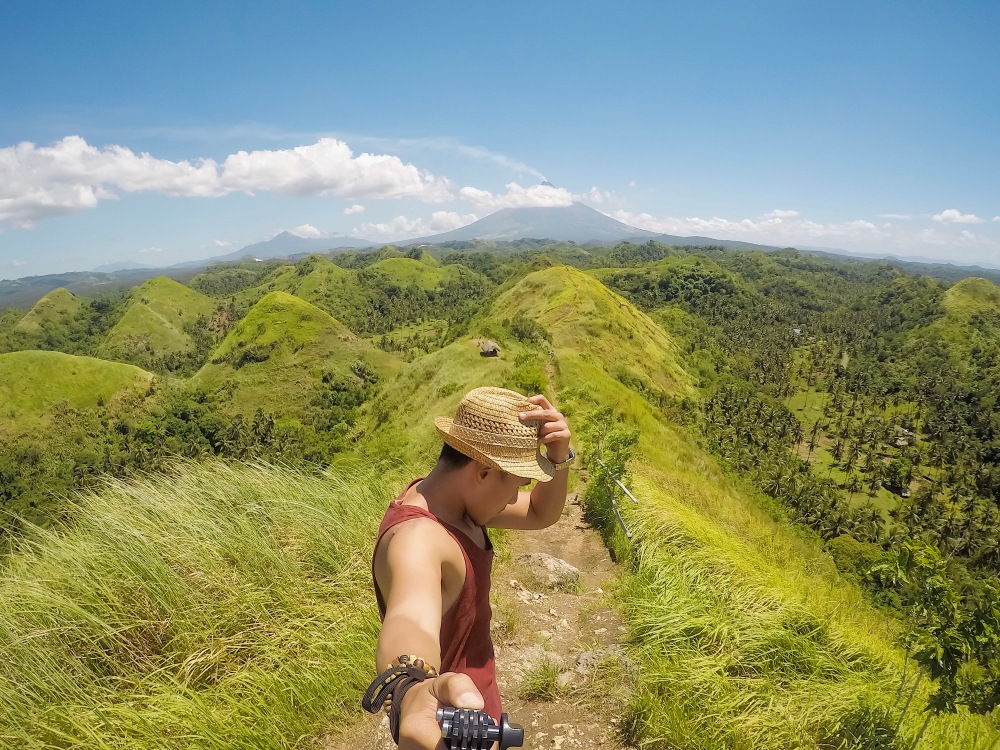
One of the challenging things I did during my solo travel in Albay was searching for places that I could explore in and around the city of Legazpi. Many people think that Albay is pretty much equivalent to the beautiful volcano of Mayon and every activity a traveler or tourist could do is limited to it. But that isn’t just true. With a great push to tourism of the previous and current LGU officials of Albay, the hidden gems within the province have started to be known. One of these is the verdant hills of Quitinday, which is just a pretty sight to the eyes. Look at the pictures of the said hills here!

Covering an area of 400 hectares, these rolling, green hills of Albay are sure to amaze every traveler. These verdant hills, which are similar to Bohol’s Chocolate Hills, can be accessed by cars, vans (via travel agencies) from Legazpi City or tricycles (special trips).
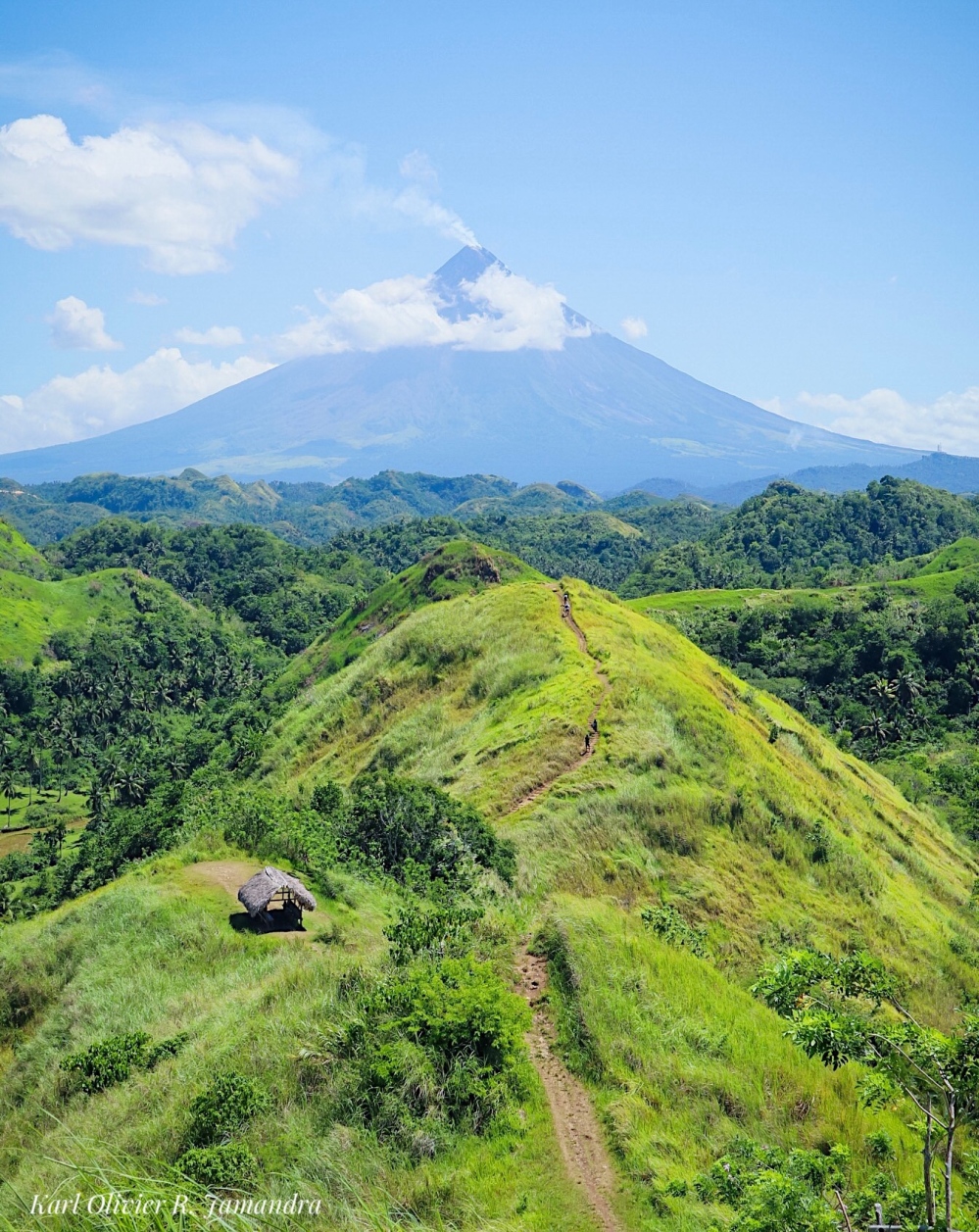
LEGAZPI BOULEVARD
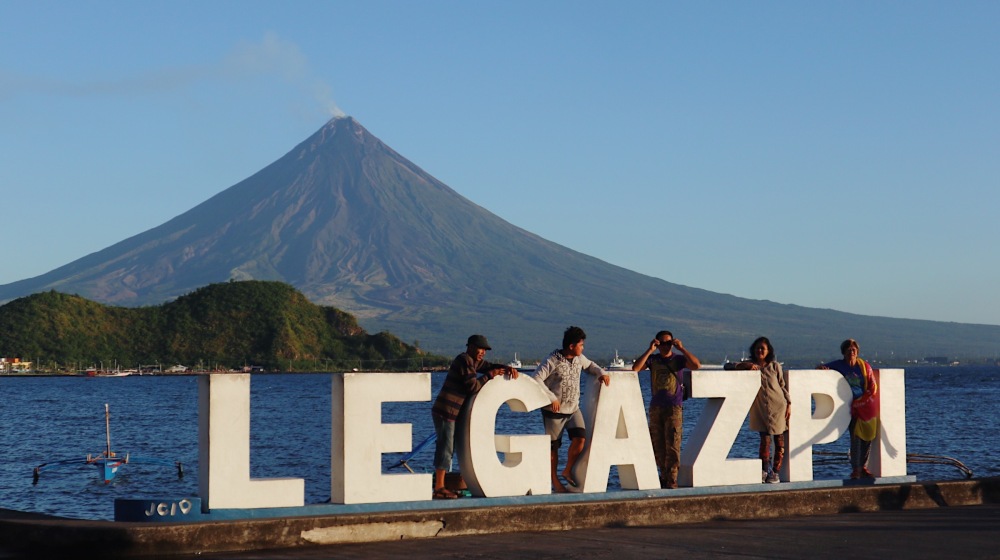
You can opt to go to Legazpi Boulevard to have a good view of Mayon with Kapuntukan Hill and Albay Gulf in the foreground. This coastal road network is said to connect the city’s central business district and port area. People go here to jog, run and bike. I also remember clearly there was a Zumba class happening the time I visited here one Sunday morning! Should you find yourself hungry, the boulevard has eateries, cafes and restaurants to fill your tummies! Legazpi Boulevard is also a popular destination of sports activities and competitions.
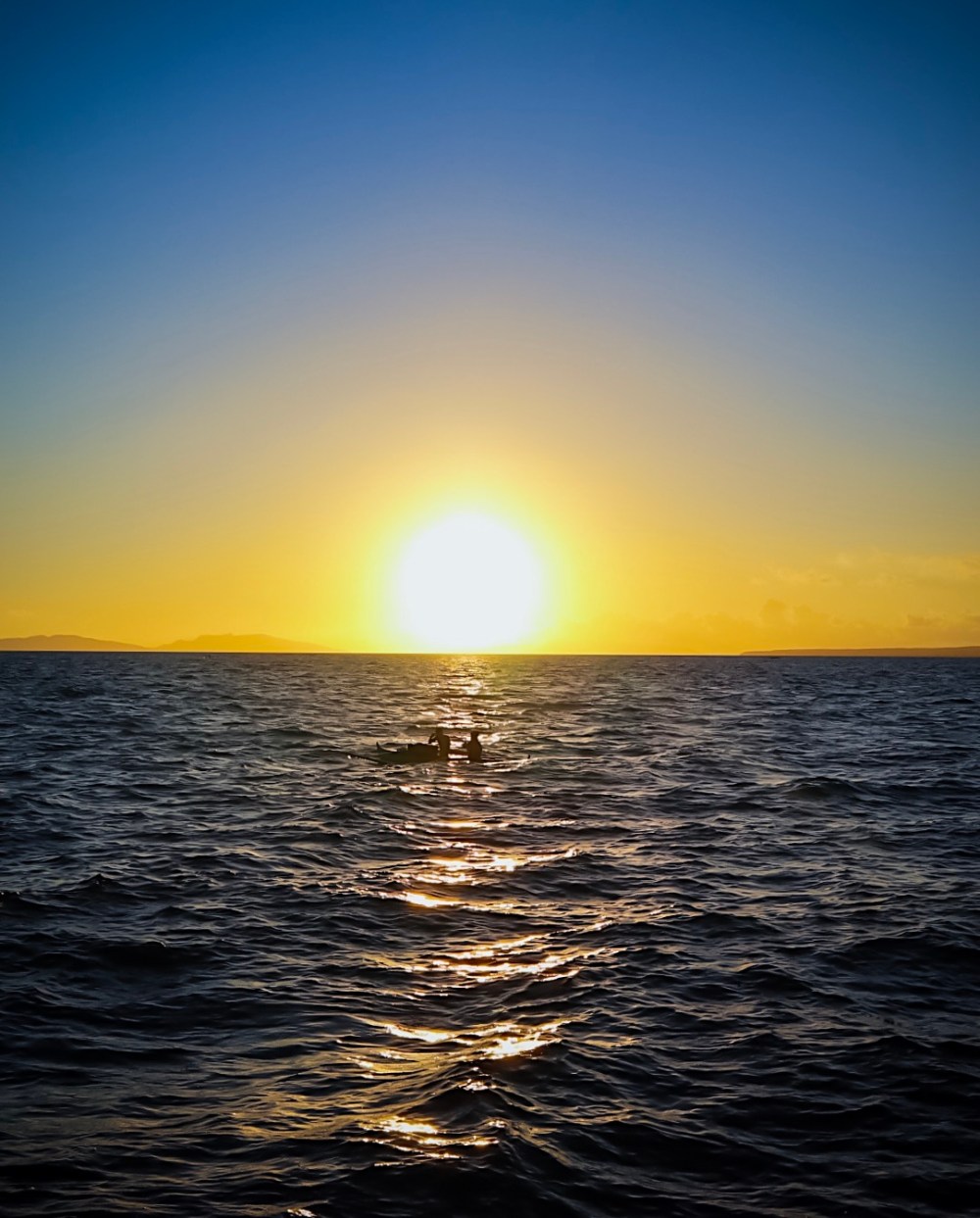
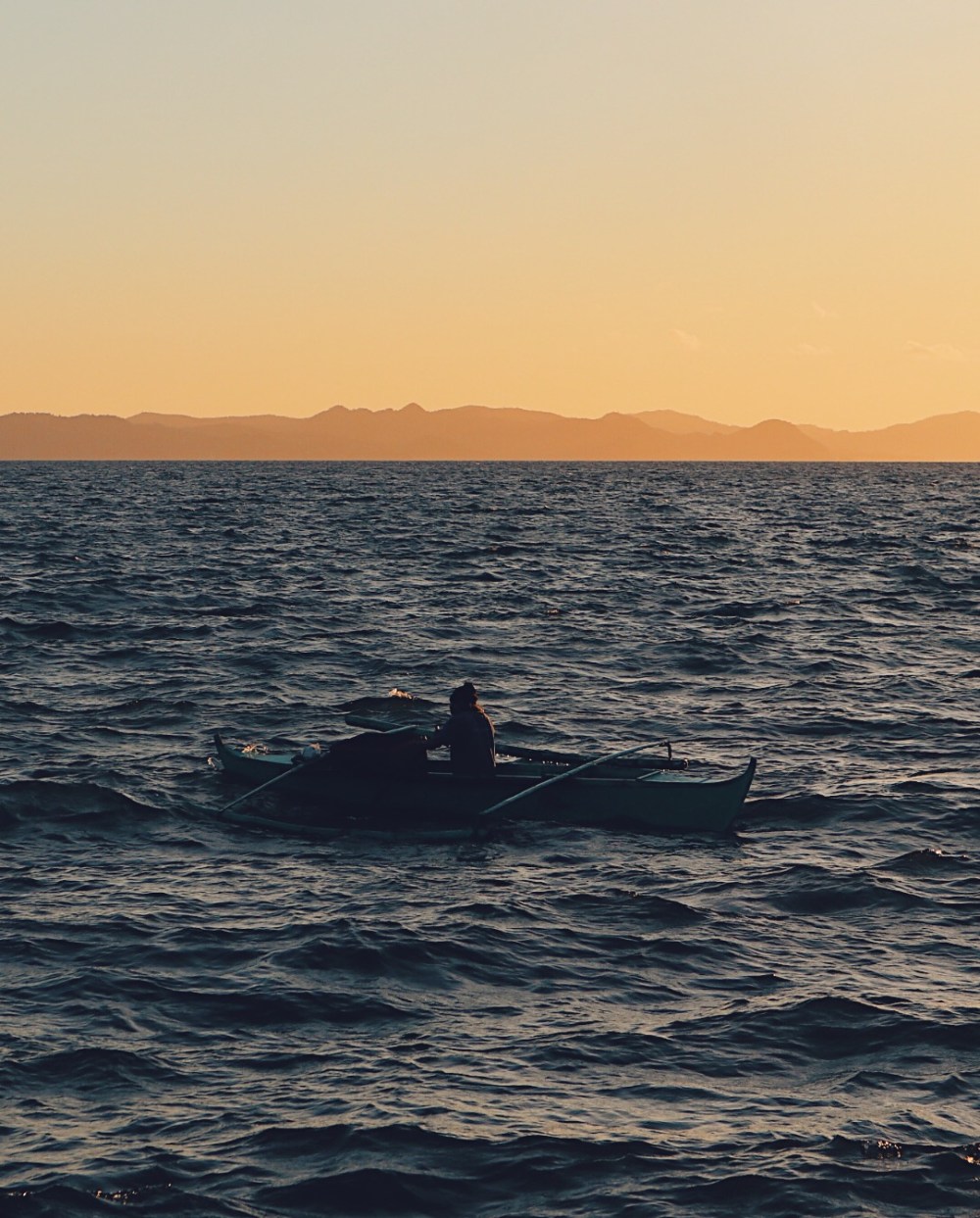

WHERE TO EAT
First, a thought on eating while traveling: My idea of traveling has changed for the past several years because I have always seen food as just a commodity wherever you may go. I thought you could just eat anything that you fancy while traveling regardless of what it is. The important thing is getting to the places you have been wanting to go to. Obviously, I wasn’t thinking very clearly then. I know better now. Yes, food is a commodity, but it is also distinctive to the place based on who lives in it, what crops they grow and animals they raise, and probably, what they also believe in. Therefore, food is an integral part of the people’s culture. Disregarding it would be a sign of disrespect to the people of the place you’re visiting.

The whole region of Bicol is known for their love and liking to spicy food. Bicol express and laing are just some of their contributions to the Filipino cuisine. I have always tasted these dishes and as a fan of spicy food, I really like them. But when I found out that some restaurants in Legazpi are serving them in a new, exciting way, I was in. I thought I want to try them for myself! And so one night during my #TrueWanderer travel adventure here, I entered Small Talk, ironically one of the most talked about food places there.
SMALL TALK CAFE

Location: 51 Dona Aurora St. (near Albay Provincial Capitol along Rizal Avenue)
Opens at 11 AM and closes at 10 PM
Established in 1999, Small Talk Cafe is a restaurant that serves authentic Bicolandia dishes and fusion cuisine. From pastas, pizzas, sandwiches to pies, cakes and sili ice cream, they serve varied dishes with a twist of Bicolano flavor.
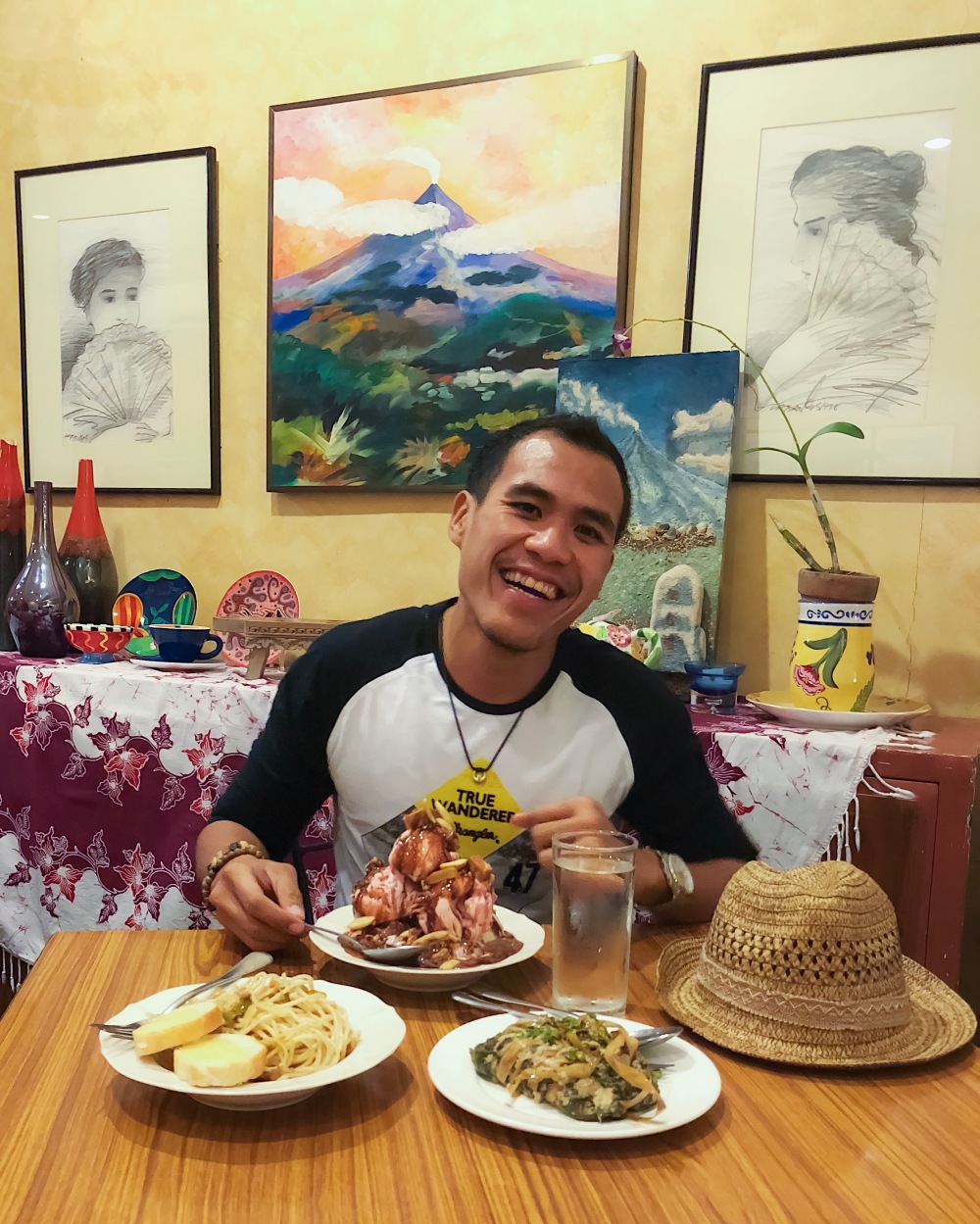
During my #TrueWanderer trip, I ordered Bicol Express Pasta, a twist to Bicol’s endeared spicy pork dish; Pinangat, which is very similar to laing; and the most surprising of them all: Mayon Hot Lava Ice Cream, which consists of huge scoops of spicy ice cream!!!

The Bicol Express Pasta was tasty and tangy. I love how they were able to pull off a very spicy dish into a pasta! Pinangat, which is made up of meat, coconut milk and chili wrapped in taro leaves and bundled with coconut leaves, was also so good! It was my first time to eat it that day, and I liked how the taro leaves have perfectly enhanced the flavor of the spicy and creamy coconut sauce. Now, I have tasted what they call spicy ice cream before, but this one’s a lot different. Mayon Hot Lava Ice Cream’s got real chilis! As in siling labuyo! Scoops of vanilla, chocolate and strawberry ice cream with mouth-watering syrup and pili nuts are embedded with chili! It didn’t take long before I gulped for water because the resto’s true to their word. This ice cream really IS spicy! Haha. And it clearly is not for those who have a weak stomach for unusual food!
Eating in this cafe is best done in groups so you can order varied dishes that you can share with each other! But of course, it’s also good whether you’re solo or with a partner!
HOW TO GO TO LEGAZPI
BY BUS
If you’re coming from Metro Manila, head to Cubao or Manila and ride a bus going to Legazpi. There are several bus liners that serve commuters traveling from Manila to Legazpi and vice versa. These are Cagsawa Travel and Tours, Inc. (Padre Faura Street, Ermita, Manila- 09174815809; and Araneta Center Bus Station, Cubao- 09176063918), ALPS The Bus, Inc. (Cubao, 09237314798), Philtranco (Cubao, 09178604418), Peñafrancia Bus [Cubao, (02) 366-6302/ 366-6298 / 437-2015 / 277-2327], Isarog Bus (Cubao), RSL Bus (Padre Faura Street, Ermita, Manila- 09088512587), Amihan Bus Lines [Araneta Center Bus Station, (02) 474-8708], DLTB Bus Company (Araneta Center Bus Terminal, Cubao- 09264354215; Taft Avenue, Pasay- 09161234567; EDSA, Pasay- 843-0246), and Raymond Transportation (Cubao- 09437097457, Manila- 7339380).
Take note of the travel schedule of these buses as they won’t always be available every hour of the day. Their trips start at the following times: 4 AM (Raymond Transportation), 6:30 AM (DLTB), 7 AM (Philtranco), 7:30 AM (Peñafrancia), 8 AM (Cagsawa) and 8:30 AM (Isarog Bus, Amihan, ALPS). Meanwhile, their last trips are as follows: 8:30 PM (Cagsawa), 8:45 (Philtranco), 9 PM (ALPS, Isarog, DLTB), 9:30 PM (Peñafrancia), 10 PM (Amihan), and 11:30 PM (Raymond).
Bus fare ranges from P750 up to P1100 depending on the type of bus you’re riding in. For the complete schedule and price range of the bus liners mentioned above, please visit this link: http://wowlegazpi.com/manila-to-legazpi-bus/
Riding the bus may be the most accessible way of going to Legazpi, but it certainly is not the fastest. Travel time usually takes 9 to 12 hours.
Important reminder: Buses are almost always filled up during peak seasons (holidays, summer break) that’s why I highly recommend for you to reserve a ticket in advance. Contact the bus lines on how you can do so, or better yet go to their ticket booths to reserve.
BY AIRPLANE
Riding the airplane is the fastest way of traveling to Legazpi. There are three airlines that serve passengers who are going to Legazpi from Manila: Philippine Airlines (PAL), Cebu Pacific and Cebgo. Flights are available daily. Check the respective websites of these airlines to learn more about their schedule. The cheapest airline fare is around P1,500, but this would mostly depend if it’s peak season or not.
If you’re coming from Cebu, PAL and Cebgo also have direct flights going to Legazpi.
WHERE TO STAY

For backpackers, I highly recommend Mayon Backpackers Hostel. This hostel has rooms that are good for sharing with fellow travelers, and also rooms for families and groups of friends. They have a shared kitchen where you can prepare and cook your food, use their dishes and utensils to eat, drink water from their water dispenser and also refrigerate food and drinks in their ref! Also, once you check-in here, you are entitled with a free breakfast. What’s more? It has a good view of Mayon!
Address: Diego Silang St., Bgy. Maoyod Subdivision, Old Albay, Legazpi City
Contact number: 0905-518-6076
SAMPLE ITINERARY
I highly recommend that you make your own itinerary when going to Albay. It will depend on how many days you’d be staying here, as well as what places you want to go visit. Of course, you’d like to visit all of the places I’ve put here, but there are more that you can add depending on the number of hours you spend on each travel destination. Anyway, here’s a sample itinerary that you can use during a weekend in Legazpi City.
Night before DAY 1
9 PM – Ride bus from Manila to Legazpi
DAY 1
7 AM- Arrival in Legazpi
7:30 AM- Early check-in at the hostel. If your room is not yet available, ask if you can leave your things first at the reception. Eat breakfast.
8 AM- Ride the jeepney going to Camalig. Drop off at Quitinday Junction/ Diversion Road. Look for tricycles that take tourists to the site. Round trip would cost P500, good for about 4 to 5 passengers.
9:30 AM- Arrival in Quitinday Hills. Go to registration site and pay environmental fee (P20). Trek the hills without need for a guide.
11 AM- Go back to Camalig to have lunch.
*You have the option, though, to ask your tricycle driver if you can continue your trip to Quitinday Falls and Underground River for an additional cost of P500. I wasn’t able to do this during my stay there, but I highly recommend you to do so. Let’s say you also visited the falls and the underground river in Quitinday, you would probably be back in Camalig by 4 PM.
4 PM- Ride the jeepney going to Cagsawa.
4:30 PM- Alight in Cagsawa for the Cagsawa Ruins. Enjoy the sunset here.
6 PM- Go to Daraga Church before heading back to hostel.
7 PM- Dinner.
DAY 2
6 AM- Breakfast
6:30 AM- Head to Sumlang Lake. Ride a jeepney heading to Camalig, Guinobatan or Polangui. Tell the driver to drop you off at Albay Agri Ethno Eco Village. After the drop off, walk for 5 minutes going to Sumlang Lake.
8 AM- Go back to highway. Ride the jeepney going to Daraga (2nd loop) and head to Lignon Hill.
9 AM- Explore Lignon Hill. Pay P10 for the environmental fee. Explore the place. Also, you may ride the ATV here.
*It was through Your Brother Travel and Tours that I got to experience the ATV adventure in Albay. Their rates include picking you up on the location of your choice. My guide was very supportive both on guiding me how to enjoy the ATV and also, taking pictures and videos of me during the whole activity. You may contact them at 0905 455 7594.
1 PM- Lunch time. Head back to hostel.
3 PM- Prepare your things for check out.
4 PM- Head to Legazpi Boulevard for sightseeing and picture-taking. You may also eat snacks here or even early dinner before heading to the bus terminal.
7 PM- Go to the bus terminal. It is best that you reserve your tickets in advance so you won’t have a hard time looking for a bus going back to Manila. Your arrival time in Manila would depend on the bus as well as the time you’ll successfully be riding going home. Remember it would usually take 9 to 12 hours of travel time.
***
I hope you had a great time reading this blog post about Legazpi City, guys! If you have comments, suggestions or recommendations, just hit me up! Thank you!
